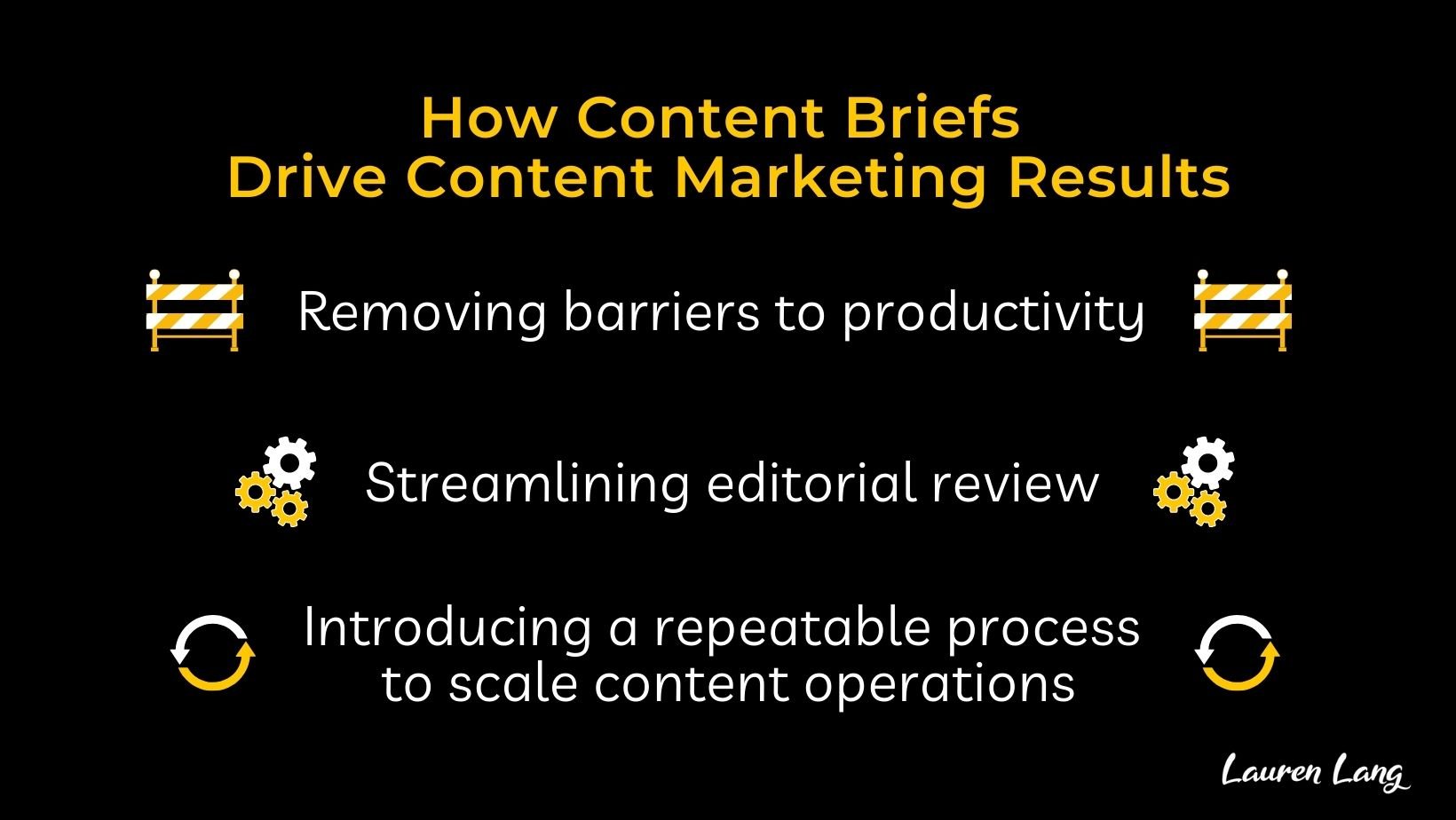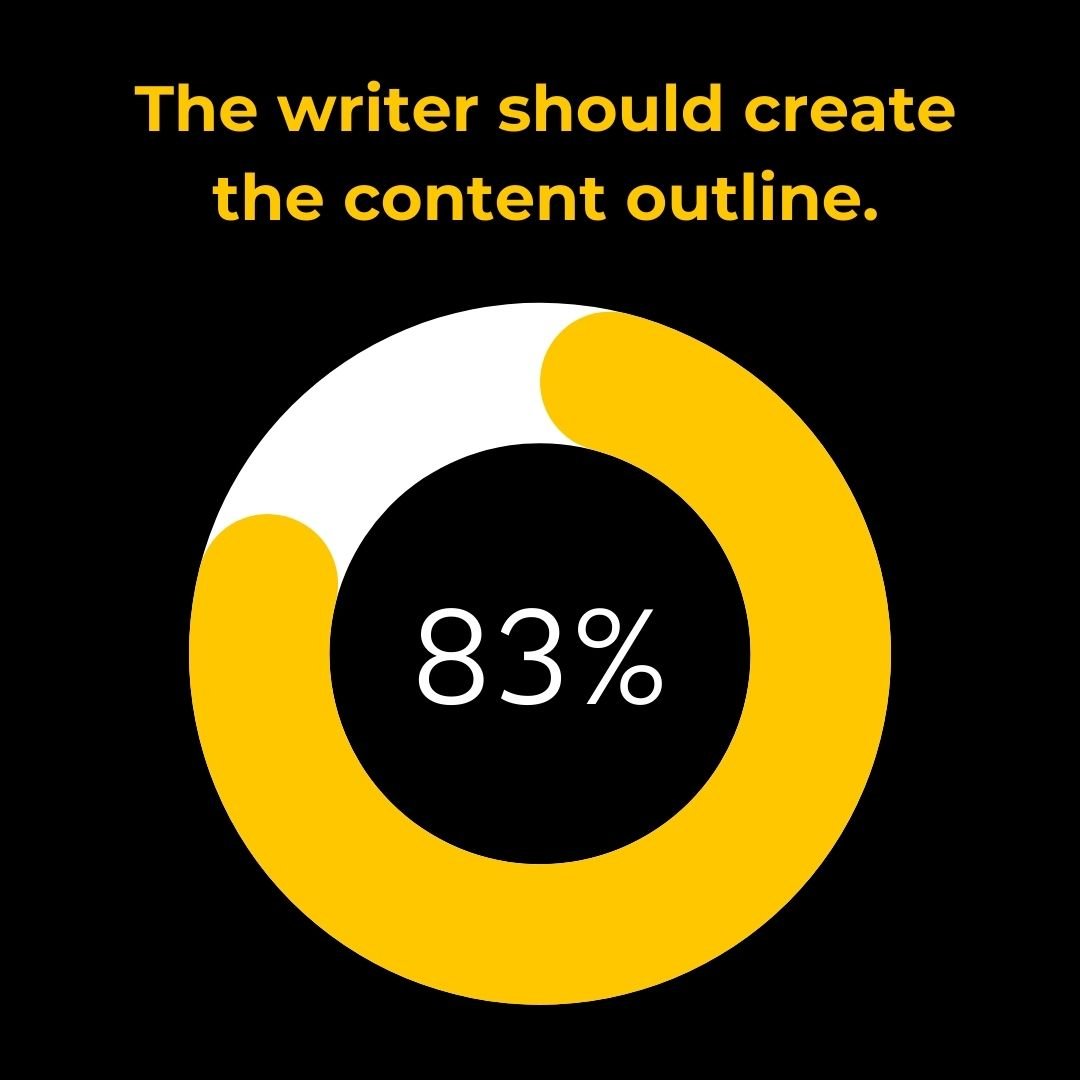How to Write a Killer Content Brief
Scaling a content marketing engine in your organization can be a messy process. Bringing more writers on board means more variables—different projects with different due dates at different stages of draft and revision and approval involving different stakeholders and contributors. Getting great results the first time and minimizing the back-and-forth of the editorial process is key.
So how do you maximize your chances of success? With a kickass content brief.
To do content marketing effectively, each top-of-funnel blog post should fulfill a specific purpose. It should address a problem or question that a specific audience persona struggles with, providing helpful answers and proposing actionable solutions.
And the more that you leave this up to chance (or to a five-minute conversation or a hastily fired off email to your content writer), the less likely the blog post is going to hit the mark.
Instead, a content brief is a fantastic way to communicate all the necessary textual and contextual information about a content piece in one easy format. In this article, I’ll cover what a content brief is, why you should use one, how to write a brief that your content writers will love, and where you can go to get some fantastic content brief templates of your own.
What Is a Content Brief?
A content brief is a detailed writing assignment that lays out all of the required features, specifications, and qualities of a specific piece of content (often a blog post, but sometimes a whitepaper or an ebook, a webinar, a research report, or something else).
Essentially, it’s a roadmap to help a writer nail all of the fundamentals and create an effective piece.
When I used to teach college writing, I would spend hours toiling away to craft the perfect essay assignment. Why? Because I wanted my students to have everything they needed to succeed. I was committed to not letting any lack of clarity on my part be the reason a paper missed the mark. It was my job to communicate clearly what I wanted and what would get an A on the assignment.
I no longer teach English (thankfully), but to me, the same principle applies. I can’t expect the writers I hire to do good work if I don’t lay out a) what good work is, and b) how to make it happen. As a content lead, that’s my responsibility.
And you know what? Writers agree.
“What makes a brief useful is that it serves as a shortcut to all of the knowledge I would already acquire as an in-house writer,” says content writer Kayla Voigt. “If I've been working with you for more than six months, I don't necessarily need a full brief, but if this is the first time I'm working with a new brand, I want to make sure I have all the information I can!”
How Content Briefs Drive Content Marketing Results
Content briefs offer a lot of value both to the content lead (or client) and to the content creator, and they allow both parties to drive the business KPIs that matter most in content marketing. They do this by removing a lot of unnecessary friction from the content production process:
1. Briefs remove barriers to productivity
Think about how you’d begin to write a blog post with no direction. Not only would you have to research the topic, but you’d have a lot of supplemental research to do on top of that. What SEO keywords should you use? Which persona should you target, and what tone and style should you adopt for them? How long should a good article on this topic be? What’s the best CTA to use?
That’s a lot of context switching for a writer, returning again and again to your company website or sending you email after email for clarification. It breaks up the workflow and the creative process and introduces costly delays while they wait on answers. A content brief prevents those headaches by compiling everything the writer needs on the content team side to get started.
The result? More good content in less time. (Yes, please.)
2. Content briefs streamline editorial review
You know what I hated as a teacher grading essays? Surprises.
Sometimes an essay would surprise me in good ways… but it wasn’t often. Most of the time, a “surprise” meant the author was going way off track, coming up with some wacky theory completely unsubstantiated by evidence or logical thought.
Even in professional contexts, misunderstandings can happen -- but they can be prevented by good communication. A content brief helps eliminate some of those unpleasant surprises that might come when what a writer turns in is not what their client was envisioning. This makes the editing process much easier, and helps avoid awkward reviews with technical SMEs who might suddenly see their product described in ways that are inaccurate at best.
“Every industry has unwritten institutional knowledge that everybody “knows” or is aware of, but it’s rarely put down to paper. This makes it difficult for freelance writers to research on their own. A brief should include information from subject matter experts (or at the very least links to useful resources) so that the writer can maximize their time get the project done faster.”
— Patrick Icasas, Content Marketing Manager, Catalyst.io
3. Content briefs introduce a repeatable process to scale operations
A content brief template makes sure that all the information that needs to be communicated to a writer is there—every time. Having a system is better for everyone, even if that system is a little unorthodox or unique to your organization’s needs.
For example, at TeamBuilding, every content brief includes a completely written introduction to the article. As CEO Michael Alexis explains, “The standardized structure creates consistency across our posts and also ensures major keywords are included. The pre-written intro also means that none of our content writers ever have to start with a blank page. Instead, they can read the intro, get ideas flowing, and start from there. The result is relatively rapid production of high-quality content.”
What Should a Content Brief Include?
A good content brief is a little like a story in itself. It has a structure, it has just enough detail, and it illustrates how the reader is going to move from point A to point B. While there are many different approaches to writing a content brief (as you’ll see), there are some key features that most content marketers agree are helpful.
The Context
Think of this like the 5 Ws of journalism: who, what, when, where, and why. A content brief should essentially paint a picture of the entire writing situation:
1. Target Audience. “I always start a brief from the audience part, because they are the reason we’re writing something in the first place,” says Fio Dossetto of Contentfolks. In this section, Dossetto recommends describing who the audience is, along with their primary Job to Be Done (the task that they’re “hiring” the content to help them accomplish).
Trina Moitra of Convert.com takes this even one step further: ”Our briefs come with job stories instead of vague personas. This is a very practical way the writer can put themselves in the reader's shoes and gauge whether the article has served its intent or not. ”
A job story from a Convert.com content brief.
2. Purpose. What is the overall goal of the piece? Knowing who the audience is, what are you hoping they will do, think, or feel at the end of reading it? The quantifiable goal here might be conversion on the post’s CTA, but there might be a qualitative goal too (which is helpful for a writer to know).
3. Main Message or Angle. Just as a list of keywords does not a content strategy make, a single keyword isn’t a content topic. As Content Harmony founder Kane Jamison explains, a brief is an opportunity to give the writer notes on the brand’s angle when it comes to the topic:
“A WordPress theme company and a WordPress hosting company are going to have different approaches to writing about the same topic. Many companies will leave it to the writer to figure out, when a few sentences could point them in the right direction and prevent potential rewrites.”
4. Tone, Voice, and Style. If the writer isn’t familiar with your brand voice, you’ll want to include some helpful tips here. Otherwise, is there a specific tone or style that works better for your target audience? Writers report that this is often an area where briefs leave a lot to be desired: “A tone guide of ‘professional, friendly, smart’ tells me nothing,” says writer Jordy Fujiwara. “That's what everyone wants. Or at least most people don't want the opposite.”
A better guide gives examples, telling writers what to do and what not to do—or at the very least links to a brand style guide where all of this is clearly defined.
5. Brand mentions or products to highlight. We’re in an age of product-led content. How prominently do you want your product to feature in the content piece? Should it be subtly woven into use cases? Mentioned as a possible solution to a common problem? Promoted heavily?
“Just give your writers the basics: a working title, a few bullet points of the key themes/topics that the blog should cover, a short list of keywords, and some links to similar blogs or resources for inspiration. I find that if you give your writers too much information, it stifles their creativity. Most content marketers are smart, talented people – let them surprise and impress you!”
— Joe Barron, Content Manager, www.cognism.com
The Specs
If the context is the 5 Ws in a content brief, the specs are the “how” of the project. What are the objective requirements for the piece? What does it need to include to achieve the desired outcomes?
1. Deadline and word count. These are details your writer will need to know anyway, so putting them all in one place just keeps everything neat and tidy.
2. Keywords. Include a primary keyword and other possible secondary keywords you’d like to see used throughout the piece. And while a list of keywords can be helpful, Trina Moitra is quick to warn against treating SEO as an afterthought: “At Convert, we clearly define the seed keyword, secondary keywords, entities, internal linking candidates, citation candidates, and topical relevance builders so that search engine optimization is baked into the content.”
3. Internal links and external sources. Are there helpful sources you’d like to suggest (or require) that your writer pull from? What about internal links that the piece should link back to? Having a clear idea of where this piece should live in your content funnel can help narrow down ideal sales pages or landing pages in the reader’s next steps.
4. Calls to action. The right call to action for a piece of content isn’t always obvious to a writer. As Patrick Icasas explains, “Writers don’t often have the benefit of context—of what the blog means in the grand scheme of your content plan and marketing strategy, or how it is seen internally. All they see is a series of one-off projects.” Defining the right call to action for the logical next step in your audience’s journey will help give more context to the writer so that the piece is a natural lead-in to that CTA.
5. Graphic needs. “I think it's rare that you can build an awesome piece of content without having some custom visual elements,” says Kane Jamison. “Ideally a brief should have some direction on potential graphics or elements to visualize, and also leave it open to the writer to suggest what these assets can be. My normal process is having a graphic designer get started around the time the writer completes the first draft.”
“Remember that in writing there should be a balance between the non-negotiables (SEO data, semantic relevance) and narrative and flow, for a piece to be successful. Here at Convert, each brief is accompanied by an explanatory video that clears up this difference. What is a hard requirement and where can the writer explore to infuse the article with their personality. This has been a gamechanger for us.”
— Trina Moitra, Head of Marketing, convert.com
The Outline?
Opinions and practices vary on who should create the outline for a content piece: the content editor or the content writer.
Once I’ve established a relationship with a writer, there can be some more flexibility I introduce into the content brief process. For example, I might have them create an outline based on the rest of the information I provide. This gives writers more leeway to get creative which can yield better results, as Nneka Otika explains: “When a brief is too strict, it often means excluding other information that could have made the content better. And the client isn't happy because their content is just like everything that is out there. This can easily be prevented if there’s more room for me to add to the brief as the writer.”
Alex Birkett of Omniscient Digital agrees: “I use minimum viable content briefs for my personal content….I don’t add personas, minute style guide deadlines, or detailed outlines. I'd rather have my writer spend time writing than doing needless paperwork and documentation before the post goes out.”
In fact, I did an informal survey of 35 content marketers in my network: 83% of them believe that the writer should create the content outline.
That said, some content editors prefer to write the outlines themselves. “The outline is an integral part of the brief in our case,” explains Emilia Korczynska, head of marketing at Userpilot. “We work with more than 10 freelance writers who are a) at different experience levels, and b) not experts in the product field. They’re not as familiar with our product as we are, so we need to control that for quality. Plus it's critical for SEO.”
And as Fio Dossetto notes, the detail of an outline depends on who’s writing it (and for whom). A general sketch of top-level points might be fine for a writer outlining their own piece, but “when you’re outlining for someone else, you may need to flesh out the document a bit more—enough for the writer to know what you’re expecting, but leaving ample space for them to contribute ideas and expertise.”
3 Content Brief Templates You Can Download Right Now
If you haven’t used a content brief before, it’s helpful to try some templates first to see what works for you and your needs. As you’ll see, they can vary according to each company or marketing department’s focus and level of detail required. Here are of my favorite three free, open, and copyable Google Doc content brief templates that you can start using immediately.
Best Simple Content Brief Template: Zapier
Fitting all on one page, Zapier’s content brief template (Google Doc) is a great beginner step. It’s more SEO focused and pared down than others, which makes it ideal for small businesses beginning to scale content production. It’s also a great starter doc for companies that would like to create their own briefs but want a template to iterate on.
Best Comprehensive Content Brief Template: Contentfolks
This template from Fio Dossetto at contentfolks is one I’ve used time and time again. It’s incredibly detailed (including an outline template for folks who’d like to go that way) and highlights some features popular in SaaS such as the JTBD framework and a product-led content approach.
Best Content Distribution Brief Template: Orbit Media
As Orbit Media co-founder Andy Crestodina says, “An ally in content creation is an ally in content promotion.” This distribution-focused content brief template has a lot of the key features of the others, especially when it comes to content specs and SEO, but it also includes other fields for opportunities for guest posting, incorporating influencers into the content, distributing the content through organic channels. At the bottom, this template also includes a list of best practices that Crestodina reinforces in his courses and his book.
Bonus! One Tool to Try: Content Harmony
Once you have a content brief down, it becomes a repeatable and modular process—and one that’s perfect for digitizing and automating (at least to some extent). Content Harmony is a brief-building tool that taps into keyword data and imports some of these factors automatically. It also has some cool functionality like analyzing search intent for a certain keyword on SERPs and pulling in competitor blog post structure so that you can build on what content competitors are doing. Content Harmony isn’t free, but it does offer your first 10 briefs for $10 as a trial period so that you can try it out and see if it works for you.
I'm a content strategist helping B2B SaaS companies leverage empathy to communicate value, empower customers, and drive revenue. You can learn more about my content strategy process, 1-on-1 consulting calls, and group training workshops, and I’d love to connect with you on LinkedIn!


















